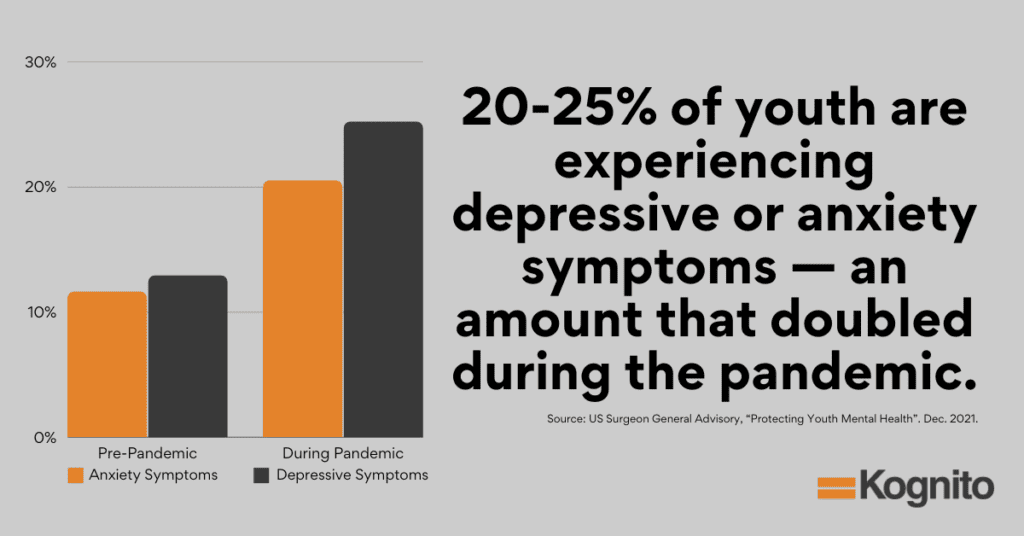Students in Distress: How to Spot Warning Signs
Today’s students from Pre-K to college are facing unprecedented mental health challenges. Up to 1 in 4 youth are experiencing depressive or anxiety symptoms, and youth psychiatric visits to emergency departments for depression, anxiety, and behavioral challenges increased by 28% in just four years, according to a recent US Surgeon General Advisory.
Educators are uniquely positioned to detect the warning signs that a student might be in distress. Research has proven that early detection is critical, making it important for teachers to understand what to look for and how to respond when they think a student may be struggling.
Warning signs vary slightly by age group. In this post, we’ll share some risk factors to be aware of, as well as warning signs of distress in young children, teens, college students, and virtual students.

Risk Factors for Mental Health Conditions
There are certain risk factors that can increase the likelihood that a student might struggle with mental health challenges. If you’re an educator, you probably have a sense of this already. When schools across the country shut down in response to the COVID-19 pandemic, these were the students you worried about most.
Students may be particularly at risk if they:
- Are part of a marginalized group
- Have been exposed to adverse childhood experiences (ACEs) such as abuse, neglect, or community violence
- Live in poverty or are socioeconomically disadvantaged
- Survived a disaster
- Experienced temporary living arrangements, loss of personal property, and parental unemployment
- Lost a loved one or friend
- Use alcohol or other drugs
Warning Signs of Distress in Children
Younger children respond to trauma very differently from older children and adults. It can be more difficult to recognize the prevalence of mental health challenges because a younger child may not be able to effectively communicate their feelings. They are also developing at a rapid rate and changing constantly, which makes it harder to label changes in behavior as concerning.
Here are warning signs of distress in children ages 6-11, according to SAMHSA:
- Withdrawing from playgroups and friends
- Competing more for the attention of parents and teachers
- Being unwilling to leave home
- Being less interested in schoolwork
- Becoming aggressive
- Having added conflict with peers or parents
- Having difficulty concentrating
Warning Signs of Distress in Teens
According to CDC data, in 2019, over one-third of high school students had experienced persistent feelings of sadness or hopelessness, a 40% increase since 2009. Teens are facing an immense amount of academic and social pressure, not to mention they are still grappling with the effects of the COVID-19 pandemic.
Early detection is critical. Here are the warning signs of distress in children ages 12-18, according to SAMHSA:
- Becoming withdrawn
- Resisting authority
- Becoming disruptive or aggressive at home or in the classroom
- Experimenting with high-risk behaviors such as underage drinking or prescription drug misuse
Warning Signs of Distress in College Students
Up to 44% of college students reported having symptoms of depression and anxiety, and suicide is the third leading cause of death for college students. Campus counseling centers are overloaded, and nearly half of them have added staff to try to meet the need.
But counseling centers aren’t in the classroom. They can’t see the warning signs unless a student chooses to seek assistance. Educators and campus leaders can play a critical role in identifying warning signs and connecting students to campus resources.
Here are some warning signs of distress in college students, according to the St. Mary’s College of Maryland Wellness Center:
- Social isolation, withdrawal, lethargy
- Inability to focus on a specific topic in a conversation or activity
- Disorganized thinking and speech, feelings that are inappropriate to the situation, lack of affect, or other evidence that the student is “out of touch with reality”
- Expression of feelings of persecution, strong mistrust of others
- Violent outbursts
- Signs of excessive alcohol or drug use and misuse
- Expressions of general unhappiness over a period of several weeks
- Frequent class absence or “disappearance” over extended periods
- Gain or loss of significant amounts of weight
- Abrupt change in manner, style, or personal hygiene
- Increasing dependence on you (by making excessive appointments, hanging around your office or after class) or others
Warning Signs of Distress in Virtual Students
Virtual learning is more prevalent than ever. While it can be more difficult to spot warning signs through online platforms, there are some things to look out for, including:
- Decreased participation in class
- Poor attendance
- Frequently reporting illness
- Incomplete assignments
- Negative interactions with parents on camera
- Zoning out and not being mentally present
- Short-term memory loss due to increased levels of stress
Social isolation can be a challenge with virtual learning. In the spring of 2020 (during school closures), 15,000 high school students in Los Angeles didn’t log on for virtual classes. Regular one-on-one check-ins with students can provide opportunities for connection and offer a platform for crucial conversations.
Give Educators Life-Saving Knowledge and Skills
Providing a nurturing and safe learning environment is critical to supporting the social, emotional, and academic development of students at all levels. Kognito’s immersive, interactive online learning experiences help teachers, professors, and school staff gain knowledge and skills related to mental health so that they can identify students in distress, connect with them using proven communication techniques, and refer them to professional resources when needed. Using role-play conversations with virtual humans, our simulations offer a practice-based learning environment that’s completely online.
Request a demo now, and see how conversations with virtual humans can make a real difference for your students.